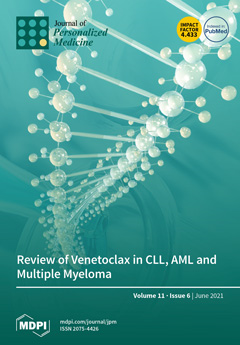MICA (major histocompatibility complex class I chain-related gene A) interacts with NKG2D on immune cells to regulate host immune responses. We aimed to determine whether
MICA alleles are associated with AS susceptibility in Taiwanese.
MICA alleles were determined through haplotype analyses of major
[...] Read more.
MICA (major histocompatibility complex class I chain-related gene A) interacts with NKG2D on immune cells to regulate host immune responses. We aimed to determine whether
MICA alleles are associated with AS susceptibility in Taiwanese.
MICA alleles were determined through haplotype analyses of major
MICA coding SNP (cSNP) data from 895 AS patients and 896 normal healthy controls in Taiwan. The distributions of
MICA alleles were compared between AS patients and normal healthy controls and among AS patients, stratified by clinical characteristics. ELISA was used to determine soluble MICA (sMICA) levels in serum of AS patients and healthy controls. Stable cell lines expressing four major
MICA alleles (
MICA*
002,
MICA*
008,
MICA*
010 and
MICA*
019) in Taiwanese were used for biological analyses. We found that
MICA*019 is the only major
MICA allele significantly associated with AS susceptibility (P
FDR = 2.25 × 10
−115; OR, 14.90; 95% CI, 11.83–18.77) in Taiwanese. In addition, the
MICA*019 allele is associated with syndesmophyte formation (P
FDR = 0.0017; OR, 1.69; 95% CI, 1.29–2.22) and
HLA-B27 positivity (P
FDR = 1.45 × 10
−33; OR, 28.79; 95% CI, 16.83–49.26) in AS patients. Serum sMICA levels were significantly increased in AS patients as compared to healthy controls. Additionally,
MICA*019 homozygous subjects produced the highest levels of sMICA, compared to donors with other genotypes. Furthermore, in vitro experiments revealed that cells expressing
MICA*019 produced the highest level of sMICA, as compared to other major
MICA alleles. In summary, the
MICA*
019 allele, producing the highest levels of sMICA, is a significant risk factor for AS and syndesmophyte formation in Taiwanese. Our data indicate that a high level of sMICA is a biomarker for AS.
Full article






